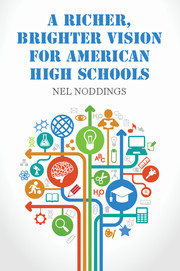Book contents
- Frontmatter
- Contents
- Introduction
- 1 Unity of Purpose
- 2 Vocational Programs
- 3 What Might Have Been: Women's Traditional Interests
- 4 A Better Adult: Continuing the Search
- 5 Parenting
- 6 The Common Core Standards
- 7 Critical Thinking
- 8 Collegiality, Caring, and Continuity
- 9 The Curriculum and Its Setting
- 10 Planning, Enacting, Evaluating
- 11 The Professional Preparation of Teachers
- 12 Reflecting on the Brighter Vision
- Notes
- Bibliography
- Index
3 - What Might Have Been: Women's Traditional Interests
Published online by Cambridge University Press: 05 June 2015
- Frontmatter
- Contents
- Introduction
- 1 Unity of Purpose
- 2 Vocational Programs
- 3 What Might Have Been: Women's Traditional Interests
- 4 A Better Adult: Continuing the Search
- 5 Parenting
- 6 The Common Core Standards
- 7 Critical Thinking
- 8 Collegiality, Caring, and Continuity
- 9 The Curriculum and Its Setting
- 10 Planning, Enacting, Evaluating
- 11 The Professional Preparation of Teachers
- 12 Reflecting on the Brighter Vision
- Notes
- Bibliography
- Index
Summary
What might the school curriculum have looked like if women had been involved in its planning from the start? Women are not all alike, of course, and it would be a mistake to suppose that they could be represented by a single, universal mind. Indeed, to build on that supposition would be to repeat the error made by so many men in the past. However, it is undeniable that women lived for centuries under the expectation that they would spend their lives maintaining a family and household. In the “best” homes and families, girls learned at home how to manage this challenging work. But how should these “best” homes be described? Just as we must continually deepen our exploration of what should be meant by a “better adult,” we must similarly examine the nature of “best homes.” If we can discover some powerful possibilities, it would make sense to include this information in the school curriculum.
There is a great emphasis today on the connection between poverty and education, and it is often assumed that schools could be more effective if something were done to alleviate poverty. This is almost certainly true. However, it should be worthwhile to explore the idea that educating for better home life might contribute not only to a reduction in poverty but to the greater effectiveness of schools in teaching the standard curriculum. The single most important factor in determining children's success in school is almost certainly the quality of their parenting, and yet we teach little or nothing in our schools about parenting. A whole chapter (Chapter 5) will be devoted to this topic. What else about home life should appear in the school curriculum?
HOUSEKEEPING
It is not unusual for thoughtful critics to poke a bit of fun at neatness. Witold Rybczynski, for example, writes: “Hominess is not neatness. Otherwise everyone would live in replicas of the kinds of sterile and impersonal homes that appear in interior-design and architectural magazines.” He goes on to describe the condition of his own study and writing desk: “covered three-deep with a jumble of half-opened books, encyclopedias, dictionaries, magazines, sheets of paper, and newspaper clippings.” He follows this with a long paragraph listing the “many personal mementos, photographs and objects” that fill his study. But notice that he has a study in which to pile up his treasures.
- Type
- Chapter
- Information
- A Richer, Brighter Vision for American High Schools , pp. 40 - 53Publisher: Cambridge University PressPrint publication year: 2015



